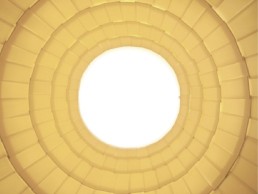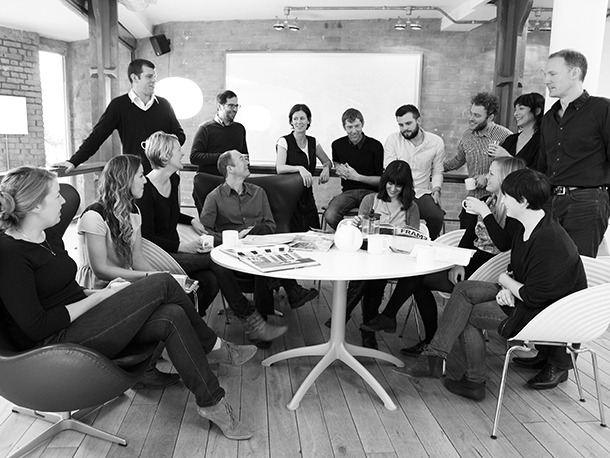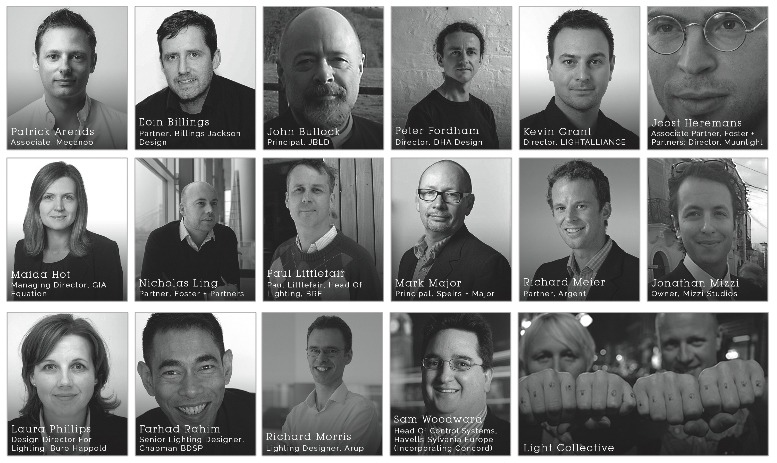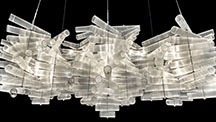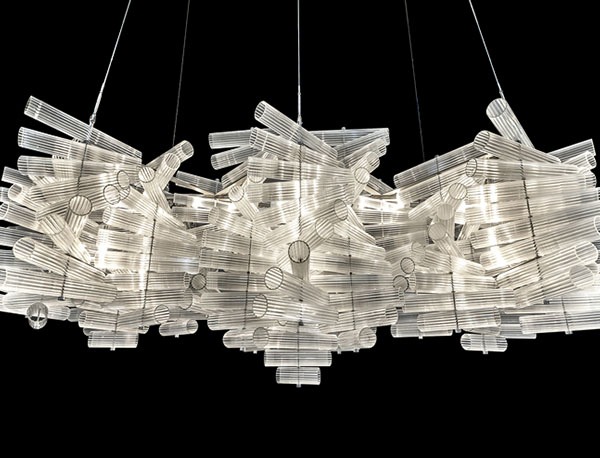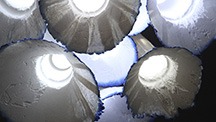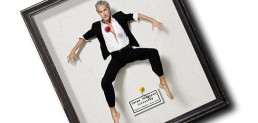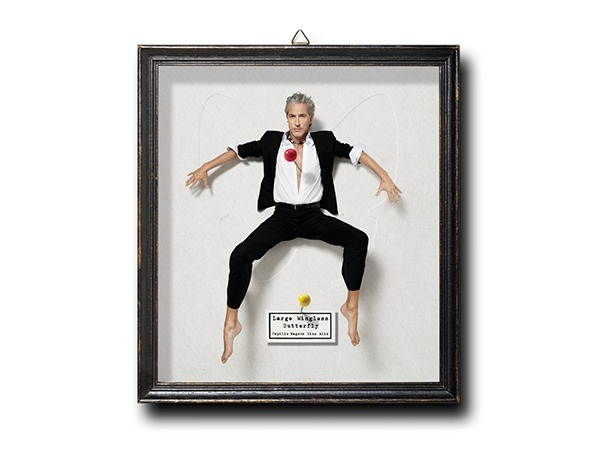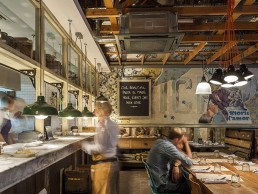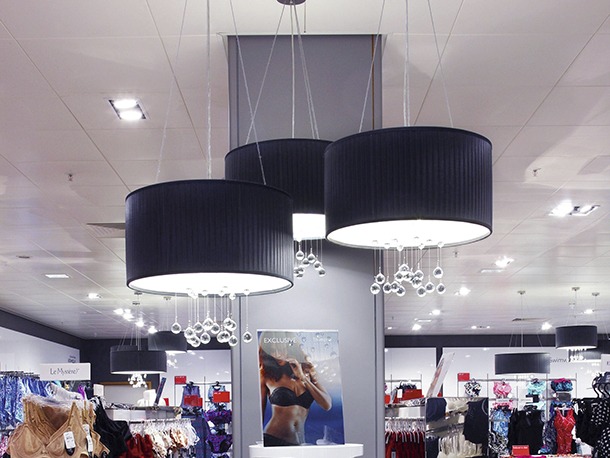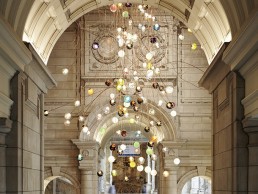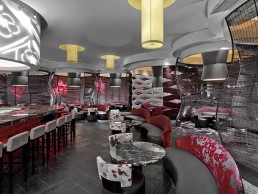The Perfect Glow
Natural light triggers a primeval response in us all. Who can deny the attraction of firelight and candles? In terms of atmosphere - no artificial light source can compete with the organic - even in these days of LED colour controllers. The simple warming glow of certain shades is unrivalled. That is why I and so many lighting and interior designers love porcelain. Surely it is the premier medium for the creation of an ambient relaxing and welcoming interior?
Apart for instances where task and function is required - many schemes avoid the use of direct light. The practice of using reflected light from a hidden source and washing light across walls are central to contemporary lighting design and there are many ways to achieve this effect. Filtering the light source through a shade is an alternative that allows for the creation of sculptured focal points in an interior. Porcelain succeeds here too. The material is wonderfully flexible and can flow into any dramatic form to fit the look of a space.
Of course diffused light can be generated by many materials but none offer the warmth and honey like glow of translucent porcelain. To create the ideal light, porcelain has to be cast paper thin and fired at very high temperatures to achieve a shade that emits pure ambience. It is ideal in bars and restaurants as it conveys conviviality. Many designers use it as a practical and fire safe alternative to candles. It flatters complexions too! Moreover it signals a warm welcome. It is used very effectively in office receptions and hotel foyers (after all the word foyer is derived from the French for fire). I know of no other lighting medium that can ‘warm’ a space more effectively.
Porcelain also makes a surprisingly happy marriage with LED light sources. You may expect a collision between this ancient material and the latest technology but you will be delighted with the result. Of course tungsten lamps are warmer in their original state but a combination of a 3000K LED through the warming filter of porcelain provides a crisp illumination which is joyous. Combine this with a RGB colour controller and you discover hues of light which have a wonderful natural intensity. A dawn-blue through a tree canopy and twilight pinks are just a few delights. Effectively porcelain expands the natural palette of light that can be achieved with artificial light sources.
Porcelain as a material is renowned for its ability to capture fine detail and relief. It adds another factor that is so loved by enthusiasts of this medium. I encountered the subtle use of light and darks in an original McCloud design – the Gracie. The raw and rough texture gave the fitting a unique appeal. I also appreciate embossed wallpaper designs and natural textures when embedded. A porcelain shade when lit can reveal textures that draw the eye and can echo patterns from the fabrics and furnishings elsewhere in the interior scheme.
In this increasingly technological world of lighting it is important to remember the importance of the natural and the organic. I challenge anyone not to be struck by the unique aesthetic that a porcelain chandelier, pendant or wall light offers. Sometimes things are better experienced than described. I invite all designers to take a look at porcelain next time they want to create a warm atmospheric space. It is a light that suits the contemporary, traditional and the classic interior in equal measure.
Andrew Orange - Lighting Designer and Consultant
www.houseoforange.co.uk
folio: Moreysmith
MoreySmith is an architectural design practice based in London. Founded in 1993 by Linda Morey Smith as the culmination of a distinguished ten-year career in the interior design industry, the practice has accrued an extensive portfolio of commercial, workplace, development, leisure and residential projects.
Last year the firm celebrated 20 years of creative solutions with the publciation of Renew, a retrospective of their work and an eye-opening overview of their impressive client list. Arup, Red Bull, Sony Music, ASOS, EMI and EPIC (to name just a handful) have all sought MoreySmith’s expertise in creating new and reinvigorated spaces.
The company mission is to deliver beautifully designed projects that reflect and embody the client, their brand ethos and needs. Projects are undertaken by employing a strategic approach underpinned with design-led and detail-focused thinking.
The practice offers architectural design, interior and exterior refurbishment, interior design, branding and property services. They work with both occupiers and developers - a major point of difference - and proclaim themselves passionate about designing environments where people love to live and work.
Designers With Light Forum established
A new conference for designers who work with lighting has been established. Called Designers With Light Forum, the free-to-attend event will take place at May Design Series, the UK's largest commercial design trade show at London ExCeL on May 18-20.
The event is being organised by the publishers of darc and sister magazine mondo*arc and is being supported by IALD, SLL and SBID. It is being sponsored by top architectural lighting brands Concord, Xicato, Megaman, Lumenpulse and acdc.
The goal of the Designers With Light Forum is to combine an exceptional conference programme with a unique networking platform that brings together individuals and companies who have not previously had the opportunity to all meet in one space. The conference provides an informative schedule of highly prolific speakers which in turn brings a distinguished list of attendees benefiting everyone involved.
Speakers include two of the UK's most respected British industrial designers, Eoin Billings of Billings Jackson and Terence Woodgate; as well as high profile architects Nicholas Ling and Joost Heremans of Foster + Partners, Patrick Arends of Mecanoo and Charles Valla of AZPML. They will be sharing the floor with some of the UK's most highly respected lighting designers including Mark Major of Speirs + Major, Peter Fordham of DHA Design, Maida Hot of GIA Equation, Laura Phillips of Buro Happold, Farhad Rahim of ChapmanBDSP and Richard Morris of Arup.
The unique aspect of the conference is the fact that many of the presentations will involve both lighting designers and architects or clients discussing a project that they have worked closely on. The format will enable delegates to learn, and ask questions, about the lighting design process of some of the biggest British architectural projects in recent times.
For example, Mark Major, Principal of Speirs + Major and Richard Meier, Partner at Argent Group will be discussing the development of King's Cross Central. Farhad Rahim, Senior Lighting Designer at ChapmanBDSP and Nicholas Ling, Partner at Foster + Partners will present their collaborative work at ME Hotel in London.
Maida Hot, Managing Director of GIA Equation and Will Montague, Development Executive, Chelsfield will discuss the digital façade lighting at London's Knightsbridge Estate.
“There are many lighting conferences and seminars across the world. However, the majority appear to be by the lighting industry for the lighting industry,” commented Paul James, editor of mondo*arc and organiser of the event. “The Designers With Light Forum will offer a more diverse range of presentations by reaching out to design professionals outside the lighting industry as well as within. Presenters will include Lighting Designers, Architects, Industrial Designers, Manufacturers and Interior Designers. A select band of professionals who have different experiences of working with light.”
A social event will also take place on the evening of May 19th with Light Collective presenting a live update of their UK Lighting Design Tree first published inmondo*arc in 2011. Sponsored by Xicato, lighting designers will be invited to attend to add their name to the developing Family Tree of the UK Lighting Design Profession.
The Designers With Light Forum will take place in a specially built seminar area in the Lighting sector of May Design Series, the UK's largest commercial design trade show. Lighting exhibitors include iGuzzini, Xicato, Concord, Megaman, Lumenpulse, Innermost, Ebb & Flow, LED Linear, Lladro, KKDC, Swarovski, Brick in the Wall, DARK, Enigma, B.lux, Modiss, Vivid, Kreon, Radiant, Beta Calco, Exenia, Avivo, Sharon Marsten, Shane Holland Design Workshops, Compact Lighting, LED Light Sheet, Astro, Grunzell, Philip Payne, MONO, Timage, Rako and Retrotouch.
Those who wish to attend simply have to register for May Design Series (www.maydesignseries.com) and ensure they arrive at the seminar area early to secure a seat. Presentations will last 45 minutes within 75 minute slots allowiing plenty of time for Q&A sessions.
SUNDAY 18TH MAY 2014
11.00am
Terence Woodgate / Ciaran Kiely, Project Marketing Manager, Megaman International
Differences in Design
12.15pm
Joost Heremans, Director, Muunlight
Learning from Architecture in Product Design
1.30pm
John Bullock, Principal, JBLD
John Bullock Plays By The Rules - A Conversation About Residential Lighting Design
MONDAY 19TH MAY 2014
11.00am
Mark Major, Principal, Speirs + Major / Richard Meier, Partner, Argent Group
Light And Darkness In King's Cross Central
12.15pm
LIGHTING DESIGNER / ARCHITECT
Farhad Rahim, Senior Lighting Designer, ChapmanBDSP / Nicholas Ling, Partner, Foster + Partners
ME Hotel, London - Hospitality Lighting Blended With Architecture
1.30pm
Kevin Grant, Director, LIGHTALLIANCE / Sam Woodward, Head Of Control Systems, Havells Sylvania Europe (incorporating Concord)
The Essential Guide To Retail Lighting
2.45pm
Jonathan Mizzi, Owner, Mizzi Studios
Fusing Light With Architecture
4.00pm
Peter Fordham, Director, DHA Design
How to light museum galleries - Revealing the secrets of The Mary Rose
5.00pm
Light Collective presents The Lighting Design Family Tree sponsored by Xicato
TUESDAY 20TH MAY 2014
11.00am
Eoin Billings, Partner, Billings Jackson Design
The Designer's Role In Redefining Light
12.15pm
Maida Hot, Managing Director, GIA Equation / Will Montague, Development Executive, Chelsfield
Digital Façade Lighting For The Knightsbridge Estate
1.30pm
Paul Littlefair, Head Of Lighting, BRE
Selecting And Planning Lighting Controls
2.45pm
Richard Morris, Lighting Designer, Arup / Charles Valla, Architect, AZPML
New Start For New Street - A Study In Façade Glare Control
4.00pm
Laura Phillips, Design Director For Lighting, Buro Happold / Patrick Arends, Associate, Mecanoo
Library Of Birmingham - The Design Challenges Of Meeting Breeam Excellent Standards
Baroncelli launches new bespoke division
Glass chandelier specialist Baroncelli has launched a new division dedicated to the creation of one-off, large-scale installations for private and public spaces. The move formalises an existing service provided by the company – one which has been growing steadily in recent years.
Dedicated to creating lighting designs for interiors throughout the world, Baroncelli Commissions stands apart from the established lighting Collection at Baroncelli. Incorporating statement installations fulfilling unique and inventive briefs, Baroncelli Commissions demonstrates the company’s skill in designing spectacular centrepieces for industry leaders working on prestigious, international projects.
Baroncelli has provided hand-crafted lighting designs for the recently opened Waldorf Astoria Ras al-Khaimah close to Dubai, a spectacular townhouse in London and the new opening of the eagerly anticipated Flooka Restaurant in Abu Dhabi.
Kraft Work... the power of paper
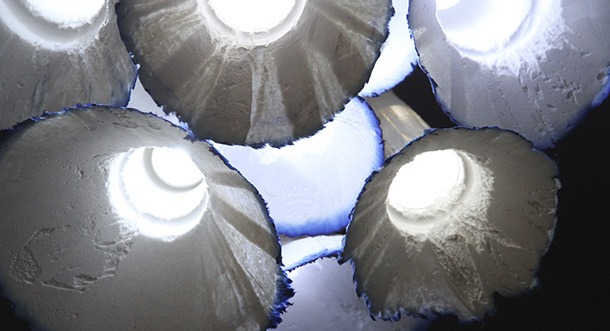
This February, the Aram Gallery in London will launch Kraft Work a new exhibition exploring the use of cardboard and paper in contemporary design. Pia Wüstenberg, Tabitha Bargh, Johannes Hemann and Iain Howlett are among the designers showing work - including examples of their unconventional decorative lighting pieces.
Alongside lighting, a range of furniture and jewellery pieces will be on display, inviting comparison on the versatility of materiasl that are more commonly associated with the prototyping stage of design.The scope of products on show describes the potential of these everyday materials when in the hands of these selected and talented practitioners
Kraft Work runs from 21 February to 12 April 2014. Entrance is free.
www.thearamgallery.org
Marcel Wanders: Pinned Up
The Stedelijk Museum in Amsterdam is currently staging a major retrospective of work by Marcel Wanders, designer and creative director of Moooi. Marcel Wanders: Pinned Up at the Stedelijk – 25 Years of Design is the first European museum show of the designer's work since 1999 -and the largest to date.
The exhibition showcases designs dating back as far as the the late 1980s, including over 400 pieces - including interiors and lamp designs.
Curator of Industrial Design at the Stedelijk, Ingeborg de Roode said of Wander's: “Few designers can boast such a combination of talents. Now, after 25 years of professional practice and at the zenith of his career, the time has come for a museum analysis.”
Wanders designs for internationally renowned brands such as Alessi, Baccarat, Kartell, Flos, Cosme Decorte, Target, Moroso, Puma, Swarovski, Marks & Spencer and KLM, among scores of others.
Marcel Wanders: Pinned Up at the Stedelijk runs from 1 February – 15 June 2014, at the Stedelijk Museum, Amsterdam.
Jamie’s Trattoria, UK
Since first appearing on UK television screens in the late ‘90s, chef Jamie Oliver has risen from fresh-faced newcomer to gastronomic impressario, presiding over an ever expanding restaurant empire. Now the Jamie’s Restaurant brand has been joined by a new off-shoot, Jamie’s Trattoria.
Jamie’s Italian wanted to create a smaller, more intimate dining experience for a new venture in Richmond, South West London. Their aim was to produce a memorable environment that would reflect a local, independent feel, while still retaining the style to which regular diners at Jamie’s have become accustomed.
Design agency Blacksheep was commissioned to create a look for the trattoria, the tenth restaurant Blacksheep has designed for Oliver over a four-year period. The team were tasked with a ‘no design’ approach in order to create a relaxed and laid back setting that would appeal to the local community.
The layout of the restaurant combines a range of different seating options - booths, an informal lounge area and a bustling shop front - all catering to a variety of clientele, from those wanting the typical Italian feast with all the trimmings, to those just nipping in for a coffee or a gelato.
Emma Freed headed the design team at Blacksheep. “One of the biggest challenges on the project was that it had a tight schedule, which meant that some aspects of the build and the design were actually being implemented simultaneously,” she explains. “Although we didn’t fully appreciate it at the time, this process in itself actually served to add to that slightly ‘scattered’ charm we were trying to create.”
In searching for the furniture that would be used in the trattoria, Blacksheep were inspired by Jamie Oliver’s passion for all things authentic and natural, which underpinned much of the development of the design.
“We sourced the W.C. cubicle doors from a salvage yard in Dorset, tiles from a local church were re-used and the booths were constructed from reclaimed scaffolding planks,” says Freed. “We added layer upon layer of different reclaimed materials from local antique suppliers, adding novelty items such as Oliver’s own pictures and vintage pieces from his warehouse, until the desired effect was created. Nothing matched, it felt much like one’s home would feel, the result of a long journey.”
The lighting fixtures play an essential role in ensuring the restaurant feels like a fully integrated part of the community.
During Blacksheep’s past work with Jamie’s the practice has developed a tradition of selecting eclectic light pieces and the Richmond trattoria was no exception.
“We have used a real mix of lighting,” says Freed, “from feature murano glass chandeliers and delicate opaque glass shades through to reclaimed factory bulkheads and EDL lamps. We also reinvented some items, such as the reclaimed anglepoise shades on brightly coloured flexes which are clustered over tables throughout the restaurant.”
With the exception of the task lamps over the waiters stations all the fittings are 230V and all are mains dimmable, as, notes Freed, “dimming is integral to any Jamie’s Italian environment.”
Where the shades cover the light sources, low energy LED bulbs have been used, but in instances where the source is visible, as with some of the small opaque glass and enamel shades, Ferrowatt squirrel Cage Filament bulbs have been specified. Indeed, these have become a Jamie’s Italian standard over the years. The exterior lighting and high level spots were supplied by Davey Lighting, while all other fixtures were reclaimed and sourced via a number of suppliers including The French House, Retrouvius, In The Woodshed, Trainspotters, The Architectural Forum and Fritz Fryer.
“It was integral to the design concept that everything had a story to tell, so the emphasis was on reclaimed fittings,” comments Freed. “Lots of the fittings were reclaimed enamel shades, however, there was also a feature murano glass chandelier and opaque glass pendants. This wasn’t possible with the exterior lighting so we specified standard Davey Lighting fittings in a traditional style.”
As Blacksheep CEO Tim Mutton observes the new Jamie’s venture, perfectly captures a shift in tastes towards a more immediate, homely aesthetic. “The inception of Trattoria itself came as no surprise to me,” he says. “More and more of today’s modern brands are quickly realising that less is more and that in a consumer driven marketplace, demand is high for venues that support an independent and local vibe. People like to feel that a restaurant is ‘their’ restaurant, a home away from home and I think Jamie’s Trattoria captures the beauty of this movement in restaurant dining perfectly.”
PF Chang’s
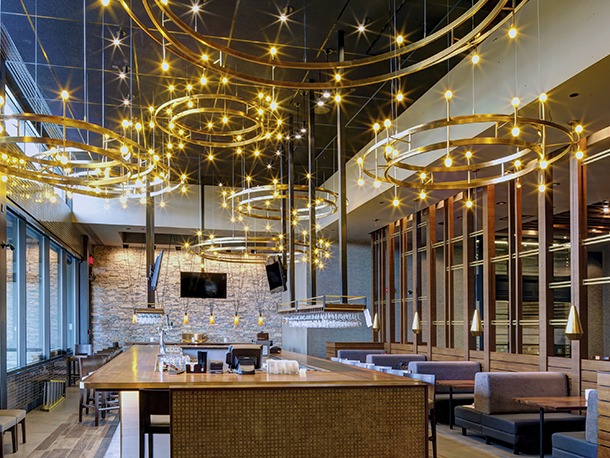
P.F. Chang’s is an Asian inspired restaurant with 204 branches across North America, South America and the Middle East. It is a growing brand that tries to produce a sleeker face with every new incarnation it opens.
Aria Group Architects, Inc. have a long running history of designing interiors for P.F. Chang’s, as well as for a number of other chain restaurants such as Nando’s and Shake Shack. The agency was again engaged by P.F. Chang’s to design their recently opened Laval restaurant in Quebec, Canada.
The restaurant chain insisted that the new build be LEED-certified, an accolade awarded by the United States Green Building Council only when a building is judged to be completely ecologically sound. Aria Group ensured the new building met all the necessary credentials for certification, implementing many new green initiatives along the way, which will be carried forward to the development of future P.F. Chang locations.
“P.F. Chang’s is not a cookie-cutter brand,” says Shannon Sterne, a senior architectural designer at Aria Group. “The design intent of this location was to maintain the recognisable feel of P.F. Chang’s and apply that to a different market using fresh, modern lighting and design elements.”
Bloom Lighting Group was chosen to develop a range of custom lighting fixtures for the project in order to achieve the aims of the design team.
On entering the restaurant ten brass ring chandeliers are immediately visible, the metal circles dominating the stylish reception and bar area.
This impressive lighting arrangement, a modernised take on the traditional P.F. Chang style, features slimmed down frames and exposed lamps, producing an industrial feel, juxtaposed against a refined atmosphere of painted stone and varnished wood.
Three different sizes of chandeliers are used, ranging from 78” to 126” in diameter. Each fixture features vertical rods, hosting light sources at both ends, distributed around the circumference of the rings. Set at different heights, and laid out in an irregular fashion, these powerful lighting statements provide a dynamic effect that adds depth to the space.
Antique finished brass pendants hang over the host stand and seating booths are complemented by brass features throughout the restaurant’s interior. Their geometric, faceted edges offer interesting and elegant detail while providing natural warmth to the space as light softly reflects off the brass finish.
The restaurant’s community table, specially designed for this setting, is illuminated by six pendants that run across the length of the space, providing a subtle glow for group get-togethers. The line of fixtures rigidly follows the shape of the table, producing an impressive visual impact.
Four matte black metal aircraft cable arms connect each light to the ceiling and three watt G4 LED lights are enveloped in amber etched glass shades that maintain the feeling of welcoming warmth throughout the bistro.
“Sometimes lighting doesn’t get noticed, but this is impactful,” says Sterne. “Patrons will notice and remember the lighting in this restaurant.”
www.ariainc.com
www.bloomlightinggroup.com
John Lewis
A series of bespoke chandeliers, produced in collaboration with Austrian lighting specialist Kolarz, bring a contemporary glamour to John Lewis’s jewellery and lingerie departments.
For many department stores - particularly those that have long remained rooted to their historic homes - the creation of an effective, engaging interior can throw up a constantly evolving series of challenges. The benefits of occupying a prime retail location are often accompanied by the restrictions of a tight floorplan and the pressures of fitting a 21st century shopping experience into a 19th century space.
Over the years, the high street’s major players have become well-versed in adapting these interiors to produce the ideal image for the product sold within each specific area.
The flagship John Lewis department store on London’s Oxford Street has undergone many evolutions and renovations over its lifetime, each one designed to keep the store relevant to modern tastes. Most recently, the brand’s internal design team focused their attention on the jewellery and lingerie departments, developing a look that could be rolled out to stores across the UK.
To achieve the right balance of style and glamour, the team worked with Austrian lighting manufacturer Kolarz to create a series of bespoke, decorative pieces.
“In developing our concept for jewellery we wanted a signature chandelier that could be adapted to the different requirements of each shop,” explains Nicola Bover, Retail Designer Interiors for John Lewis. “Working together with Kolarz we designed a chandelier which fitted our brief, was contemporary in its design and gave the jewellery department a stunning focal point.”
The lights were specially designed and produced at the Kolarz factory in Austria. Over 8,000 sparkling Kolarz crystals on each structure were combined with 200 LEDs to provide a suitably subtle light level that is low maintenance and energy efficient.
The pieces introduce a sparkling light that is picked up in glass surfaces throughout the space, while its shape provides a visual flow that draws the eye across the room.
In the lingerie and fashion advice departments, the designers took a more intimate approach. Clusters of silk organza shades, strung with Kolarz crystals that appear to float below each pendant, create a series of seductive focal points. The warm, sensual mood lighting produced perfectly complements the products on display.
www.kolarz-leuchten.at
NeueHouse, US
Our understanding of what constitutes a modern office environment has long been in a state of flux. From early experiments in hot desking, to the more recent advent of Cloud-based workspaces, individuals and companies have enjoyed an ever growing freedom to work in whatever way - and in whatever location - suits them best.
NeueHouse on Manhattan’s East 25th Street is the latest embodiment of this shifting landscape: a shared working space, open to a curated membership of small-scale, entrepreneurial companies. Its interior, created by the Rockwell Group, is a radical departure from the traditional office model, borrowing instead from the world of hospitality design in order to create a space that not only meets the highest standard of technological integration, but will also facilitate interaction between members and perhaps spark fresh inspiration and collaboration. To support this approach, Rockwell worked with Focus Lighting to develop lighting that would deliver a warm and comfortable, yet functional workplace environment within the space’s raw, industrial shell.
The ground floor’s custom, six-foot diameter, glass globe pendants (which lower into the space at night to create a feeling of intimacy) provide the apparent source of illumination, while ceiling-mounted LED fixtures above provide task and accent lighting. To ensure that the pendants have the perfect light quality and correct physical size, Focus built and hung full-scale mock-ups both within their own double-height studio space and on site. The fixtures, manufactured by Lucos Group, feature glass globes supported on a metal structure with an antique brass finish.
On the upper office floors, a three-foot diameter version provides the same ambient glow within each floor’s central lounge, while indirect fluorescent lighting, hidden in the top rail of the studio’s flexible partition walls provide the primary workspace lighting.
www.rockwellgroup.com
www.focuslighting.com
V&A Museum, UK
As the notional hub venue for London Design Festival, the Victoria & Albert Museum provides a prime location for large scale installations with the power not only to impress the international design community, but engage the wider general public. For this eleventh edition of the festival, the Canadian design brand Bocci was invited to create a chandelier that could deliver on both fronts.
Bocci creative director Omer Arbel responded with 28.280, a site-specific piece that cascades through the museum’s main atrium, a 30-metre void that cuts through the entire height of the mid-19th century building.
The installation is built around Bocci’s popular 28 pendants. The 28 pendants result from a complex glass blowing technique whereby air pressure is introduced into and then removed from a glass matrix, which is intermittently heated and then rapidly cooled. The result is a distorted spherical shape with a composed collection of inner shapes, one of which is made of opaque milk glass and houses a light source.
280 of these discreet 28 units were suspended by an erratic, vine-like, heavy copper suspension system that commands as much presence as the glass pieces it supports.
The chandelier will remain in place at the Victoria & Albert Museum until 21 November this year.
www.bocci.ca
Nobu, US
The Nobu brand is synonymous worldwide with the quality cuisine of Michelin star chef Nobu Matsuhisa and the Hollywood glamour of co-founder Robert De Niro. Though already boasting a global family of over 27 restaurants, often attached to world-class hotels, the group recently took the Nobu experience to a new level with the launch of Nobu Hotel Restaurant and Lounge, the first-ever Nobu Hotel. Located in the Centurion Tower at Caesars Palace in Las Vegas, the new venture is the product of a multimillion-dollar refurbishment project, with a new identity delivered by interior architects the Rockwell Group.
Rockwell has a longstanding relationship with Nobu and, for each of the venues they have designed, the team has married local influences with a natural, hand crafted approach using textured materials that reflect Nobu’s roots in rural Japan, as well as the freshness and delicacy of the cuisine. For this latest location, Rockwell Group combined Nobu’s signature style with a series of oversized elements that echo the largess and excesses of the Las Vegas landscape. This approach is best reflected in the restaurant itself where massive pendant pieces dominate the dining pods that line the room.
The Nobu restaurant is the largest of the all company’s eateries. Its interior concept was inspired by the Japanese concept of wabi sabi, a design aesthetic of simplicity, evocative transience and beauty in unexpected and natural rawness. The bar and lounge area feature hand-chiseled black Kadapa stone flooring, custom sofas upholstered in Donghia fabric and tables with green marble table tops.
The main dining area features five semi-private dining pods that create unique spaces that are both screening and revealing. Rockwell Group designed giant lighting fixtures, inspired by vibrant Japanese kimonos, to hang in each pod. The pieces are covered in a dark woven Chilewich fabric and are lined with purple and orange suede with a silver zig-zag pattern from Moore and Giles. With a single light source at the centre of each, the pendants provide a protective presence and intimacy within the 342-seat space.
The pendants are complemented by vast cloud-shaped paper lanterns - internally lit by LED and custom created by Molo Designs - that float across the rest of the restaurant space.
www.rockwellgroup.com


